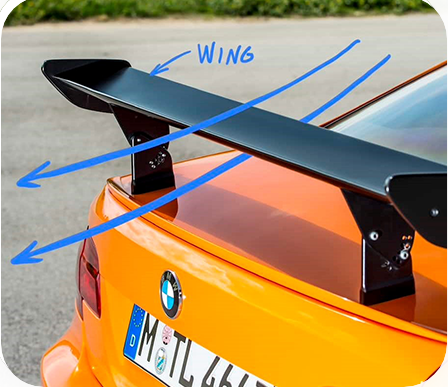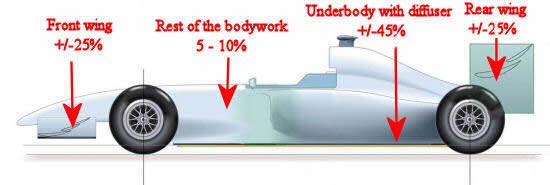
Car wings
Car wing is a device to generate downforce as air passes around it with the objective to increase drag.
Sports cars are most commonly seen with front and rear wings. These vehicles have a more rigid chassis and a stiffer suspension to aid in high-speed manoeuvrability and a wing can still be beneficial.
This is because many vehicles have a fairly steep downward angle going from the rear edge of the roof down to the trunk or tail of the car which may cause air flow separation. The flow of air becomes turbulent and a low-pressure zone is created, increasing drag and instability.
Rear wing : adding a rear one could be considered to make the air "see" a longer, gentler slope from the roof to the spoiler, which helps to delay flow separation and the higher pressure in front of the spoiler can help reduce the lift on the car by creating downforce.

Front wing: adding a front one positioned under or integrated with the front bumper is used to control the dynamics of handling related to the air in front of the vehicle. This can be to improve the drag coefficient of the body of the vehicle at speed, or to generate downforce. In passenger vehicles, the focus shifts more to directing the airflow into the engine bay for cooling purposes.

In current motor racing competitions, including Formula 1, DTM, Indy cars and Touring Car, aerodynamic downforce plays the most important role in the performance of the cars.
In the mid 1960's the use of soft rubber compounds and wider tires demonstrated that good road adhesion and hence cornering ability, was just as important as raw engine power in producing fast lap times.
The tire width factor came as something of a surprise. In sliding friction between hard surfaces, the friction resistance force is independent of the contact area (read about forensic science in braking here). It came as a similar surprise to find that the friction could be greater than the contact force between the two surfaces, apparently giving a coefficient greater than one. This would be similar to having glue on the tires, making them “stick” to the ground.
The desire to further increase the tire adhesion led the major revolution in racing car design, the use of negative lift or 'downforce'. Since the tires lateral adhesion is roughly proportional to the downloading on it, or the friction between tire and road, adding aerodynamic downforce to the weight component improves the adhesion. Downforce also allows the tires to transmit a greater thrust force without wheel spin, increasing the maximum possible acceleration. Without aerodynamic downforce to increase grip, modern racing cars have so much power that they would be able to spin the wheels even at speeds of more than 160 km/h.
Downforce, or negative lift, pushes the car onto the track.
It is said that at maximum speed, an F1 car produces 5 g's of downforce! 5 times its weight pressing it down onto the track.
Produced by almost every part of F1 car but mostly by use of diffuser and wings in the way that longer cord lenght is facing downward.
Helping to induce more tire grip, but more downforce usually induce more drag.
Downforce has to be balanced between front and rear, left and right. We can easily achieve the balance between left and right by simple symmetry, so it will not be discussed. Front and rear is a different thing. Flow in the front greatly affects flow in the back of the car, and vice versa.
Downforce must be adjusted according to racing track and behavior of the car. To much front downforce induce oversteer. To much back downforce induce understeer. Variating downforce you can resolve the problems with oversteering or understeering car. Normally, with price of adding drag.
Active wings: is one that dynamically adjusts while the vehicle is in operation based on conditions presented, changing the spoiling effect, intensity or other performance attribute. Found most often on sports cars and other passenger cars, the most common form is a rear spoiler that retracts and hides partially or entirely into the rear of the vehicle, then extends upwards when the vehicle exceeds a specific speed, such as the active spoiler in the Bugatti Veyron. Active front spoilers have been implemented on certain models as well, in which the front spoiler or air dam extends further towards the road below to reduce drag at high speed. In most cases the deployment of the spoiler is achieved with an electric motor controlled automatically by the onboard computer or other electronics, usually based on vehicle speed, driver setting or other inputs. Often the driver can manually deploy the spoiler if desired, but may not be able to retract the spoiler above a certain speed because doing so could dangerously diminish the high-speed handling qualities of the vehicle.
Material types
ABS plastic: Most original equipment manufacturers produce spoilers by casting ABS plastic with various admixtures, typically granular fillers, which introduce stiffness to this inexpensive material. Frailness is a main disadvantage of plastic, which increases with product age and is caused by the evaporation of volatile phenols[further explanation needed].
Fiberglass: Used in car parts production due to the low cost of the materials. Fiberglass spoilers consist of fiberglass cloth infiltrated with a thermosetting resin, such as epoxy. Fiberglass is sufficiently durable and workable, but has become unprofitable for large-scale production because of the labor involved.
Carbon fiber: Carbon fiber is lightweight and durable but also expensive. Due to the large amount of manual labor, large-scale production cannot widely use carbon fiber in automobile parts currently.
Source:
https://www.catchmentsandcreeks.com.au/docs/Race-Car-Aerodynamics-print.pdf
https://en.wikipedia.org/wiki/Spoiler_(car)
https://bimmertips.com/spoiler-vs-rear-wing-whats-the-difference/
https://www.formula1-dictionary.net/downforce.html
edited by arrabbiata